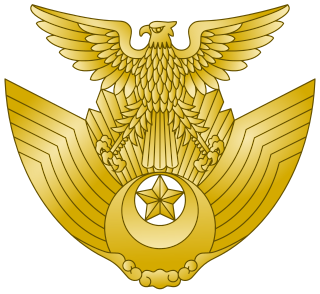
The Ministry of Defense is an executive department of the Government of Japan responsible for preserving the peace and independence of Japan, and maintaining the country’s national security and the Japan Self-Defense Forces.

The Japan Air Self-Defense Force, JASDF, also informally referred to as the Japanese Air Force, is the air and space branch of the Japan Self-Defense Forces, responsible for the defense of Japanese airspace and for other air and space operations. The JASDF carries out combat air patrols around Japan, while also maintaining a network of ground and air early-warning radar systems. The branch also has an aerobatic team known as Blue Impulse and has provided air transport in UN peacekeeping missions.

The Japan Self-Defense Forces, also known as the Japanese Armed Forces, are the unified military forces of Japan established in 1954. The self-defence forces consists of the Japan Ground Self-Defense Force, the Japan Maritime Self-Defense Force, and the Japan Air Self-Defense Force. They are controlled by the Ministry of Defense, with the Prime Minister as commander-in-chief.

The following graphs present the rank insignia of the Imperial Japanese Navy from its establishment in 1868 to its defeat during World War II in 1945. These designs were used from 1931 onward. For the typical Navy, star modelling cherry blossom was used for showing their ranks/branches, but the Naval Reserve personnel wore the compass based star before 1942, when the Reserve and Special Duty Officers were merged with the typical naval personnel's insignia.

The Japan Ground Self-Defense Force, also referred to as the Japanese Army, is the land warfare branch of the Japan Self-Defense Forces. Created on July 1, 1954, it is the largest of the three service branches.
A four-star rank is the rank of any four-star officer described by the NATO OF-9 code. Four-star officers are often the most senior commanders in the armed services, having ranks such as (full) admiral, (full) general, colonel general, army general, or in the case of those air forces with a separate rank structure, air chief marshal. This designation is also used by some armed forces that are not North Atlantic Treaty Organisation (NATO) members.
Hayao KinugasaKinugasa Hayao (衣笠駿雄) served in the Imperial Japanese Army and was one of the few ex-Imperial Army officers who joined up with the Japanese Self-Defense Forces (JGSDF) and its predecessor force, namely the National Police Reserve (NPR). In the course of his career, he served in the JSDF's Joint Staff Council and was the first commander of the 1st Airborne Brigade before he retired to private life.
The Republic of China Armed Forces in Taiwan has five rank schemes among different military branches, including Army, Navy, and Air Force. The Marine Corps, although being a part of the Navy, maintains a different insignia to other naval fleet personnel. The Military Police has insignia very similar to the Army, just with a slightly different green color. Under the current regulations, military ranks contain the following:

The Minister of Defense, or Bōei-shō (防衛相), is a member of the Japanese cabinet and is the leader and chief executive officer of the Japanese Ministry of Defense, the executive department of the Japanese Armed Forces. The minister of defense’s position of command and authority over the military is second only to that of the Prime Minister of Japan, who is the commander-in-chief. The minister of defense is appointed by the Prime Minister and is a member of the National Security Council. The current Minister of Defense is Nobuo Kishi, who took office on September 16, 2020.

The Defensive memorial cordon (防衛記念章) is the decoration for officers in the Japan Self-Defense Forces. Officials may wear it on their uniforms while in active service. They are only cordons like the Unit Awards and the Unit Citations of United States Armed Forces.

Katsutoshi Kawano was a Japanese admiral who served as the 5th Chief of Staff, Joint Staff of the Japan Self-Defense Forces from 2014 to 2019, and was the longest person to serve in that position. Prior to his appointment, he was the Chief of Staff of the Japan Maritime Self-Defense Force, the de facto navy of Japan.
Rank comparison chart of armies and land forces of Asian states.
Rank comparison chart of air forces of Asian states.

Keizō Hayashi was a Japanese civil servant, general officer and the first Chairman of Joint Staff Council (JSC), a post equivalent to Chief of the General Staff in other countries, from 1954 to 1964. He was instrumental in founding the post-war Japan Self-Defense Forces (JSDF) in 1954.

The Japan Self-Defense Force Base Djibouti is a military base operated by the Japan Self-Defense Forces (JSDF) located in Ambouli, Djibouti alongside the Djibouti–Ambouli International Airport.
Rank comparison chart of air forces of Asian states.
Rank comparison chart of non-commissioned officers and other personnel for armies/ land forces of Asian states.

The Chief of Staff, Joint Staff is the highest-ranking military officer and head of the Operational Authority (command) over the Japan Self-Defense Forces (JSDF). He or she assists the Minister of Defense on all matters of the JSDF, and executes orders of the Minister of Defense with directions from the Prime Minister.

The National Police Reserve, or NPR, was a lightly armed national police force established in August 1950 during the Allied occupation of Japan. In October 1952, it was expanded to 110,000 men and renamed as the National Safety Force. On July 1, 1954, it was reorganized as the Japan Ground Self-Defense Force (JGSDF).

The Japan Self-Defense Forces (JSDF) Marching Festival is the main cultural military tattoo in Tokyo, which features guest bands from the Asia-Pacific regions as well as bands of the Japan Self-Defense Forces. It is regularly held at the Nippon Budokan in Tokyo every November. With the festival being established in 1963, it is one of the oldest military tattoos in the Asia-Pacific region.










































































































































































